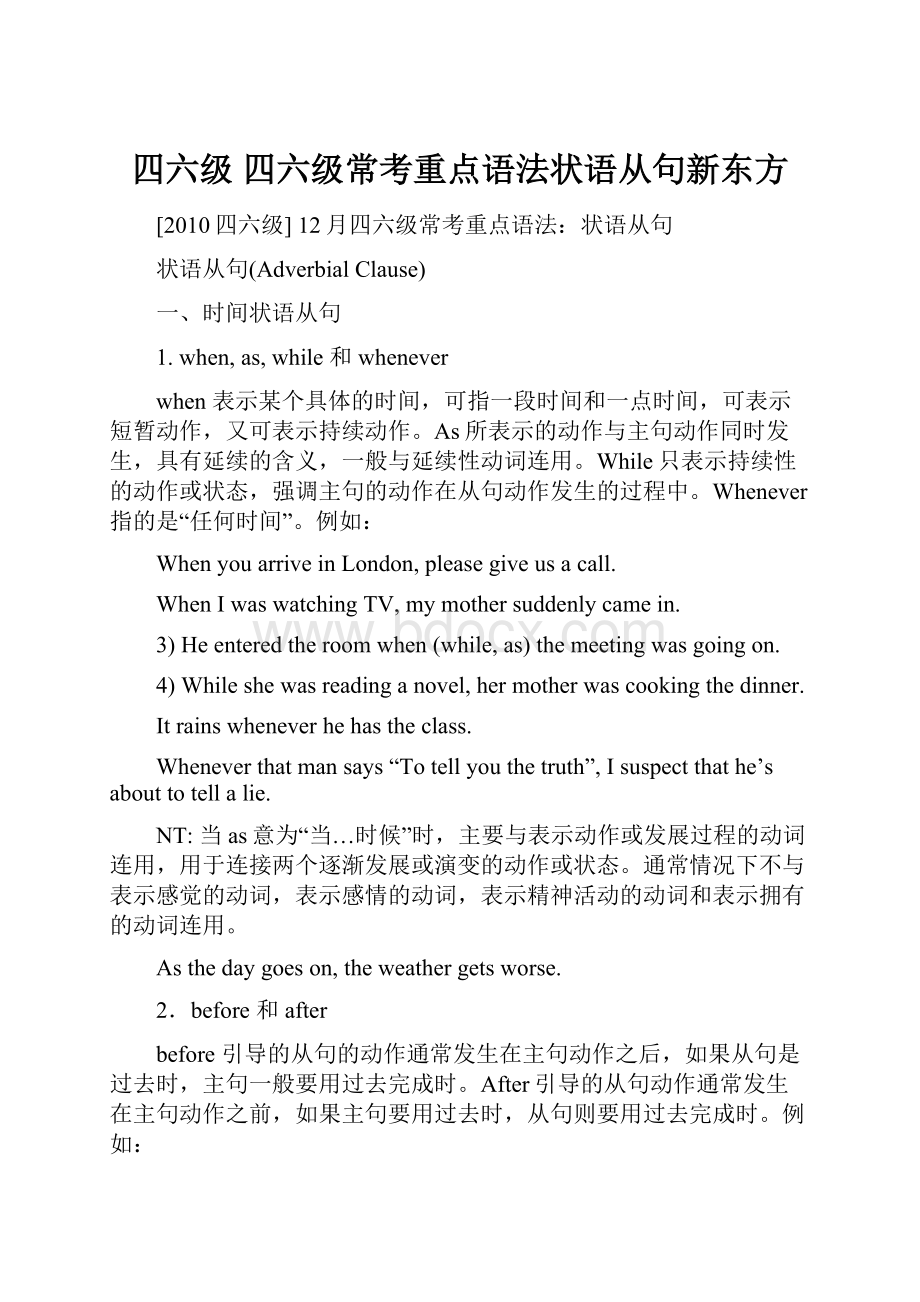四六级 四六级常考重点语法状语从句新东方.docx
《四六级 四六级常考重点语法状语从句新东方.docx》由会员分享,可在线阅读,更多相关《四六级 四六级常考重点语法状语从句新东方.docx(8页珍藏版)》请在冰豆网上搜索。

四六级四六级常考重点语法状语从句新东方
[2010四六级]12月四六级常考重点语法:
状语从句
状语从句(AdverbialClause)
一、时间状语从句
1.when,as,while和whenever
when表示某个具体的时间,可指一段时间和一点时间,可表示短暂动作,又可表示持续动作。
As所表示的动作与主句动作同时发生,具有延续的含义,一般与延续性动词连用。
While只表示持续性的动作或状态,强调主句的动作在从句动作发生的过程中。
Whenever指的是“任何时间”。
例如:
WhenyouarriveinLondon,pleasegiveusacall.
WhenIwaswatchingTV,mymothersuddenlycamein.
3)Heenteredtheroomwhen(while,as)themeetingwasgoingon.
4)Whileshewasreadinganovel,hermotherwascookingthedinner.
Itrainswheneverhehastheclass.
Wheneverthatmansays“Totellyouthetruth”,Isuspectthathe’sabouttotellalie.
NT:
当as意为“当…时候”时,主要与表示动作或发展过程的动词连用,用于连接两个逐渐发展或演变的动作或状态。
通常情况下不与表示感觉的动词,表示感情的动词,表示精神活动的动词和表示拥有的动词连用。
Asthedaygoeson,theweathergetsworse.
2.before和after
before引导的从句的动作通常发生在主句动作之后,如果从句是过去时,主句一般要用过去完成时。
After引导的从句动作通常发生在主句动作之前,如果主句要用过去时,从句则要用过去完成时。
例如:
1)Theplanehadtakenoffbeforehearrivedattheairport.
2)Afterhehadlivedinthesouthfor20years,hedecidedtogotoseekhisfortuneinthenorth.
3)Hewasstilltiredevenafterhehadhadeighthoursofsleeping.
但是如果不强调先后,或是因为从句中使用的是某个状态动词,after和before句子结构中的谓语动词也可以都用一般过去时。
例如:
Theyarrivedatthecinemaafterthefilmbegan.
3.till和until
这两个词的用法十分近似,都表示“直到…“,但在句首只能用until。
在肯定句中,主句要用延续性动词;在否定句中,until或till可以和非延续性动词连用,这时until和before同义。
例如:
Notuntiltheyhadfinishedtheworkdidtheygohome.
IdidnotlosemyconfidenceuntilIfailedseventimes.
Ididnotgotobeduntilmymothercameback.
Weranandran,tillIthoughtmyheartwouldburst.
4.aslongas,everytime,eachtime,nexttime
aslongas表示“只要”;everytime表示“每次”;eachtime表示“每逢”;nexttime表示“下次”,它们可以直接引导句子。
1)Iamhappyaslongasmychildrenare.
2)Hewillcontinueworkingaslongashehasthestrength.
Shewillnotsitsolongasshecanlieonthebed.
Shesmileseverytimesheseesme.
IamgoingtoseehimnexttimehecomestoShanghai.
5.once,assoonas,theinstant(that),themoment(that),,theminute(that),directly和immediately
这几个连词引导的从句都表示从句动作一发生,主句动作随即发生,意为“一…就”。
例如:
1)Shecametothesceneimmediatelysheheardofthebadnews.
2)Theytoldmethenewsthemomenttheygotthemessage.
3)Onceyouunderstandthisrule,youwillhavenofurtherdifficulty.
4)Sheweptaloudassoonassheheardthenews.
6.Nosooner…than和hardly(scarcely)…when
这两个连词词组都是表示主句与从句动作随即发生,意为“一…就“。
主句动词用过去完成时。
如果Nosooner,hardly或scarcely位于句首,主句要倒装。
例如:
1)Hehadnosoonerenteredthehousethenitbegantorain.
2)Nosoonerhadheenteredthehouse,thanitbegantorain.
3)Hehadhardlygonetobedwhenthetelephonerang.
4)Hardlyhadhegonetobedwhenthetelephonerang.
二、地点状语从句
地点状语从句表示在主句中某一动作或状态发生的地点或进行的方向,这类从句通常由Where,wherever或everywhere引导,可以放在主句前,也可以放在主句后。
Where指“在某个地方”,wherever指“在任何一个地方”,everywhere指“每一…地方”,意思与wherever相近。
例如:
1)Bamboogrowswellwhereithasplentyofrain.
2)Whereveryougo,whateveryoudo,Iwillbeherewaitingforyou..
3)Everywhereyougo,Iwillfollowyou.
三、条件状语从句
1.if和unless
if表示正面的条件,意为“如果”,unless表示反而的条件,意为“除非,如果不”例如:
1)Ifyou’vegotexamstomorrow,whyaren’tyoustudying?
2)Thesportsmeetingwillbegintomorrowunlessitrains.
NT:
在条件状语从句中常用一般时表示将要发生的动作。
2.providing,provided(that),supposing,suppose(that),onconditionthat和incase
这些连词(词组)意思相近,有“如果,只要,假如,假使,在…条件下”等意思。
例如:
1)YoucanarriveinBeijingearlierforthemeetingprovidedyoudon’tmindtakingthenighttrain.
2)Onconditionthattheliquidiscooledstillfurther,itwillturntoasolid.
3.onlyif和ifonly
Onlyif引导的从句用陈述语气,意为“只要”;ifonly引导从句要用虚拟语气,意为“要是…就好了”。
1)Onlyifyouhavepersistence,youcanachievegreatsuccess.
2)IfonlyIhadwings,Iwouldbeabletotravelaroundtheworldeasily.
4.where有时也可以表示条件(常用于谚语和习语)
1)Wherethereisawill,thereisaway.(有志者事竟成)。
2)Thereisneverpeacewheremenaregreedy.(人类贪欲不止,世界和平无望)。
3)Birthisnothingwherevirtueisnot.(如果没有品德,出身再好也等于零)。
四、原因状语从句
1.because,since,as和for
because表示原因语气最强,常用于回答以疑问词“why”引导的疑问句。
because从句一般位于主句后面。
for引导的从句并不说明主句行为发生的直接原因,只是提供一些有助于说明情况的补充说明,且不可位于主句前。
since表示一种附带的原因,或者表示已知的显然理由,意为“既然”,引导的从句常放在句首。
As所表示的理由最弱,只是对主句的附带说明,重点在主句,as通常放在主句前。
例如:
1)Theteacherisstrictwithusbecausehewantsustomakerapidprogress.
2)Sinceyouarefreetoday,youhadbetterhelpmewithmymathematics.
3)Asthedaywasfine,theydecidedtogoonatrip.
4)Itrainedlastnight,forthegroundiswetthismorning.
2.seeing(that),considering(that),now(that),inthat,given(that)
这几个连词同since意思相近,都有“鉴于某个事实”的意思。
例如:
1)Nowthatyouareabigboy,youmustbehavebetter.
2)Mendifferformbrutesinthattheycanthinkandspeak.
3)Givenitisgoingtoraintomorrow,thesportsmeetwillbeputofftonextmonth.
3.not…because
本结构中not否定的是because引导的整个从句。
例如:
Iamgoingonatriptomorrow,becauseIhaveto,notbecauseIwantto.
Hestole,notbecausehewantedthemoneybutheliked.
五、让步状语从句
1.though,although,evenif和eventhough
(1)这四个词(词组)都有“虽然,即使,尽管”的意思,evenif和eventhough带有强调的意味,语气较强,though和although语气较弱,though比although通俗,但不如although正式。
让步状语从句可以放在主句前或主句后。
例如:
1)Althoughtheydidheavyworkthatday,theywereallinhighspirits.
2)Shecarriesonthejobevenifshehashadabadcoldforseveraldays.
(2)英语不允许在though或although从句后用but。
如果要强调前后两个部分的对比意义,可以在主句前加上yet或still。
例如:
Althoughshehasalotofmoney,yet(still)sheisnothappy.
2.nomatterhow(what,when,which,who,where)
这几个短语意为“不管怎样(什么,什么时候,哪一个,谁,什么地方)”,例如:
1)Donotbelievetherumor,nomatterwhorepeatsit.
2)Hekeepstakingphysicaltraininginthewinternomatterhowcolditis.
3.whatever,whenever,wherever,whoever,whicheverhowever
这几个词也可以引导让步状语从句,相当于nomatterwhat(when,where,who,which,how)。
例如:
1)Whateverworkwedo,weshoulddoourbest.
2)Howeverhardasolidmaybe,wecanchangeitsshape.
NT:
however引导让步状语从句时,与它所修饰的词一起放在句首。
4.让步状语从句的倒装
though引导的让步状语从句可以倒装,也可以不倒装。
用as引导的让步状语从句必须倒装。
如果名词放提前放在句首,该名词前不可加定冠词或不定冠词。
常用的句型为形容词(副词,动词,名词,过去分词)+though(as,that)+主语+谓语。
例如:
1)Bravelythoughwefought,wehadnochanceofwinning.
2)Smartashewas,hewasnotabletosolvetheproblem.
3)Childashewas,hehadagoodcommandofEnglish.
六、方式状语从句
1.as和justas
二者都表示“如…,犹如…,正如…”。
justas比as强调的语气更强。
例如:
1)Intheearlydays,peoplecouldnotliveahappylifeaswedonow.
2)Mostplantsneedsunlightjustastheyneedwater.
2.asif和asthough
asif或asthough从句可以用陈述语气,表示可能符合事实的情况;也可以用虚拟语气,表示不符合事实或与事实相反的情况,意为“好像,仿佛”。
例如:
1)Somerockssparklewithanunusualbrilliancyasiftheycontainedgold.
2)Itlooksasthoughitisgoingtorain.
七、比较状语从句
1.as…as这种结构可以用于同等程度的比较,否定句用notso(as)…as。
例如:
1)Apoundofcottonweighsasmushasapoundofiron.
2)Sounddoesnottravelsofastingasesasinliquids.
2.as和than连接的比较状语从句常常省去同主句相同的部分,只留下相比的部分。
例如:
1)BillisastallasBob(is).2)Steelismoreusefulthaniron(is).
3.The…the…后面分别跟形容词或副词的比较级,意思为“越…越…”。
例如:
1)Thefaster,thebetter.2)Thehighertheairplaneflies,thethinnertheairis.
八、目的状语从句
1.sothat和inorderthat
(1)二者都表示“为了,以便”。
sothat较常用,一般放在主句之后。
inorderthat用于正式文体,引导从句可中谓语多用may/can/will+动词原形。
例如:
1)Shetakesnotescarefully(so)thatshemayusethemwhenshereviewsherlessonsafterclass.
2)HeplaysbasketballeverydayinorderthathecanbelikeMichaelJordan.
3)Wearrivedearlysothatwecouldgetgoodseats.
4)Hewrotehisdairyincodesothathiswifewouldn’tbeabletoreadit.
2.lest,forfearthat和incase
意思是“以防,以免”。
lest,forfearthat后的从句一般要用虚拟语气,形式为“should+动词原形”。
例:
1)Wemusthurryofflestweshouldmissthebus.
2)Don’tforgetyourumbrellaincaseitshouldrain.
3)Phonemeincaseyoumeetproblems.
九、结果状语从句
1.so…that和such…that这两个词组意为“如此…以至于”
常用结构如下:
so+adj/adv+that/so+adj+a(an)+n+that/such+a(an)+adj+n+that
1)Theboxissoheavythatnobodycanmoveitaway.
2)Itissoheavyaboxthatnobodycanmoveitaway.
3)Itissuchaheavyboxthatnobodycanmoveitaway.
4)Therewassomuchdustthatwecouldn’tseewhatwashappening.
NT:
such不能用于much,many之前